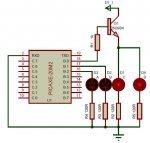Hi guys
I need to control 3 LEDs (A,B,C for ease) which are required to be on or off at specific input pin states. A and B are straight forward as the PICAXE only needs to switch them on or off. C needs to be able to switch an LED and also connect to another PICAXE in replacement of a normal on/off switch. (In the circuit diagram below I've substituted the second PICAXE with another LED for ease.)
I'm using a 20M2 and have used PICAXE VSM to design the circuitry and all works as I want it.
However, I have read numerous things on the web and looked at so many circuit diagrams and one thing seems to be repeatedly shown, the 'switched component', whether it be a LED, relay coil or motor are all on the collector side of the transistor.
Is it possible to put an LED on the emitter side of things or is that a no-no at any cost?
Angie

I need to control 3 LEDs (A,B,C for ease) which are required to be on or off at specific input pin states. A and B are straight forward as the PICAXE only needs to switch them on or off. C needs to be able to switch an LED and also connect to another PICAXE in replacement of a normal on/off switch. (In the circuit diagram below I've substituted the second PICAXE with another LED for ease.)
I'm using a 20M2 and have used PICAXE VSM to design the circuitry and all works as I want it.
However, I have read numerous things on the web and looked at so many circuit diagrams and one thing seems to be repeatedly shown, the 'switched component', whether it be a LED, relay coil or motor are all on the collector side of the transistor.
Is it possible to put an LED on the emitter side of things or is that a no-no at any cost?
Angie



